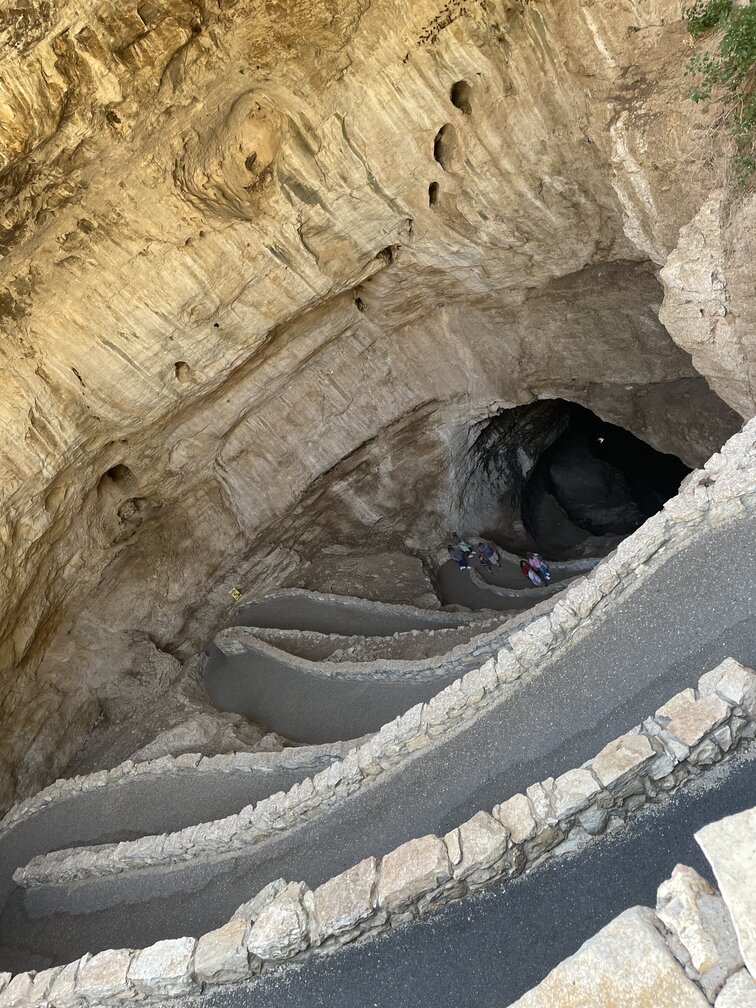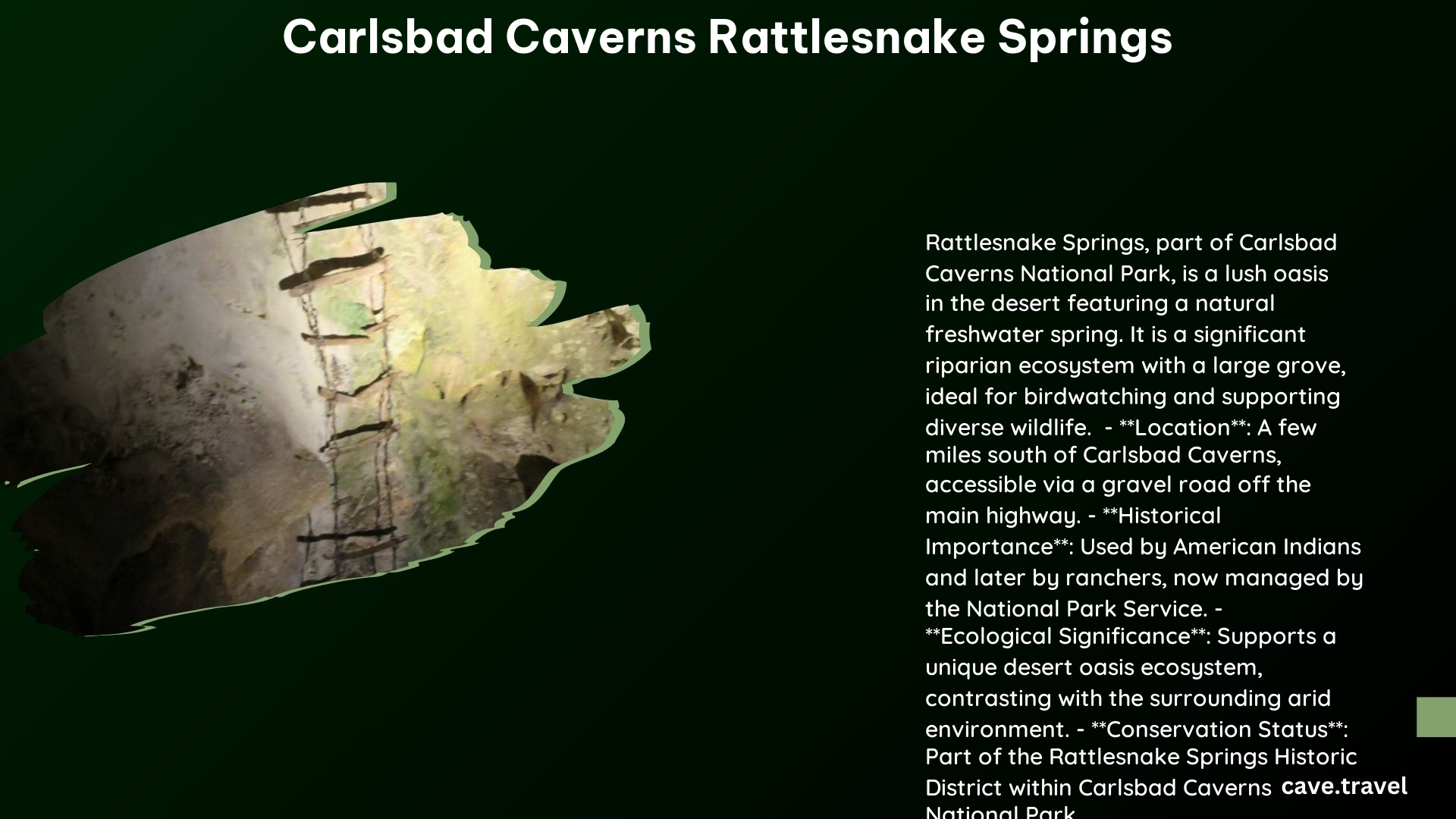Carlsbad Caverns Rattlesnake Springs is a unique and often overlooked area within Carlsbad Caverns National Park. Located about 23 miles southwest of the main visitor center, this desert oasis offers a stark contrast to the underground wonders of the caverns. Rattlesnake Springs serves as a vital water source for wildlife and a peaceful retreat for visitors seeking natural beauty above ground. While not part of the cave system, this area plays a crucial role in the park’s ecosystem and provides opportunities for wildlife viewing, picnicking, and experiencing the diverse landscapes of the Chihuahuan Desert.
What is the History and Significance of Rattlesnake Springs?

Rattlesnake Springs has a rich history that predates its inclusion in Carlsbad Caverns National Park. This natural spring has been a lifeline in the desert for thousands of years, attracting both wildlife and humans to its precious waters.
Ancient History
- Native American tribes frequented the area for water and hunting
- Archaeological evidence suggests human presence dating back several millennia
Recent History
- Homesteaded in the late 1800s by the Manzanares family
- Acquired by the National Park Service in 1934
- Incorporated into Carlsbad Caverns National Park
Ecological Significance
Rattlesnake Springs plays a vital role in the park’s ecosystem:
- Provides water for diverse wildlife species
- Supports unique riparian habitat in an arid environment
- Acts as an important stopover for migratory birds
- Hosts several endangered species of fish and plants
What Activities Can Visitors Enjoy at Rattlesnake Springs?

While Rattlesnake Springs may not offer the underground spectacles of the main caverns, it provides a range of activities for nature enthusiasts and casual visitors alike.
Birdwatching
Rattlesnake Springs is a renowned birdwatching destination:
– Over 300 species of birds recorded in the area
– Designated as an Important Bird Area by the National Audubon Society
– Best times for birdwatching: spring and fall migrations
Wildlife Viewing
The spring attracts a variety of desert wildlife:
– Mule deer
– Javelinas
– Coyotes
– Various reptiles and amphibians
Picnicking
- Shaded picnic areas available
- Tables and benches provided
- No grills or fires allowed due to fire risk
Photography
- Scenic landscapes
- Diverse wildlife
- Unique desert flora
How Does Rattlesnake Springs Differ from the Main Caverns Area?
Rattlesnake Springs offers a completely different experience compared to the main caverns area of the park. Here’s a comparison:
| Feature | Rattlesnake Springs | Main Caverns Area |
|---|---|---|
| Location | Above ground | Underground |
| Main Attraction | Natural spring and wildlife | Cave formations and bat flights |
| Activities | Birdwatching, picnicking, wildlife viewing | Cave tours, hiking, bat flight viewing |
| Facilities | Limited (picnic area, restrooms) | Extensive (visitor center, gift shop, restaurant) |
| Accessibility | Requires separate drive from main park area | Centrally located with easy access |
| Crowds | Generally less crowded | Can be very busy, especially during peak season |
What Are the Best Times to Visit Rattlesnake Springs?
The ideal time to visit Rattlesnake Springs depends on your interests and the experiences you’re seeking.
Spring (March to May)
- Peak bird migration season
- Mild temperatures
- Desert wildflowers in bloom
Fall (September to November)
- Another excellent period for birdwatching
- Comfortable temperatures
- Less crowded than summer months
Summer (June to August)
- Warmest months, can be very hot
- More wildlife activity in early morning and late evening
- Higher chance of afternoon thunderstorms
Winter (December to February)
- Coolest months
- Fewer visitors
- Some migratory birds present
Are There Any Special Regulations or Guidelines for Visiting Rattlesnake Springs?
To protect this delicate ecosystem and ensure a safe visit, there are several regulations and guidelines in place:
- No swimming or wading in the spring
- Pets must be kept on a leash at all times
- No collecting of plants, animals, or artifacts
- Stay on designated paths to minimize impact on vegetation
- No camping allowed in the Rattlesnake Springs area
- Pack out all trash and follow Leave No Trace principles
- Be aware of wildlife and maintain a safe distance
- No fishing permitted in the spring or its outflow
How Can Visitors Prepare for a Trip to Rattlesnake Springs?
Proper preparation can enhance your visit to Rattlesnake Springs:
Essential Items to Bring
- Plenty of water (at least 1 gallon per person per day)
- Sun protection (hat, sunscreen, sunglasses)
- Comfortable walking shoes
- Binoculars for birdwatching
- Camera for photography
- Snacks or picnic lunch
- Insect repellent
- First aid kit
Safety Considerations
- Be aware of the potential for encountering wildlife, including rattlesnakes
- Check weather forecasts and be prepared for sudden changes
- Inform someone of your plans if hiking in the area
- Carry a map and compass or GPS device
- Stay hydrated and watch for signs of heat exhaustion in hot weather
What Nearby Attractions Complement a Visit to Rattlesnake Springs?
While visiting Rattlesnake Springs, consider exploring these nearby attractions:
- Slaughter Canyon Cave: Offers ranger-guided tours of a more rugged, less developed cave system
- Guadalupe Mountains National Park: Located about an hour’s drive away, featuring hiking trails and the highest peak in Texas
- Living Desert Zoo and Gardens State Park: Showcases native wildlife and plants of the Chihuahuan Desert
- Sitting Bull Falls: A scenic waterfall and recreation area in the Lincoln National Forest
- Carlsbad Museum and Art Center: Provides insights into the region’s history and culture
Carlsbad Caverns Rattlesnake Springs offers a unique and often overlooked experience within the national park. Its importance as a water source, wildlife habitat, and historical site makes it a valuable destination for those looking to explore beyond the famous caverns. By understanding its significance, preparing adequately, and respecting the regulations in place, visitors can fully appreciate this desert oasis and its role in the larger ecosystem of Carlsbad Caverns National Park.
References:
1. National Park Service – Carlsbad Caverns Rattlesnake Springs
2. Audubon – Important Bird Areas: Rattlesnake Springs
3. New Mexico True – Carlsbad Caverns National Park
